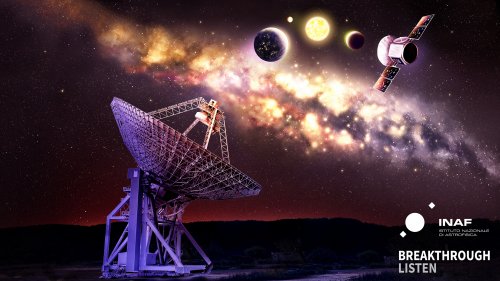
With its 64-meter diameter dish, the Sardinia Radio Telescope is one of the ten largest radio telescopes on the planet, ranking among the most efficient and technologically advanced, as it can receive a wide range of radio frequencies, from 300 MHz to 116 GHz. These features make it ideal for the search for intelligent life. Hence, a specific partnership between INAF and Breakthrough Listen was established, leading to the first observations conducted during 2021.
The team that analyzed these data in 2022 consists of Lorenzo Manunza, Monica Mulas, Luca Pizzuto, and Alice Vendrame, four students from the Universities of Cagliari and Bologna who, in the summer two years ago—under the supervision of INAF experts Andrea Melis and Maura Pilia and some American colleagues—conducted a study (the first joint effort between INAF and Breakthrough Listen) titled “The First High Frequency Technosignature Search Survey with the Sardinia Radio Telescope,” submitted to the journal Acta Astronautica.
The contribution of the Sardinia Radio Telescope was to observe specific frequencies—in the C-band (6.5 GHz) and K-band (18 GHz)—in the central region of our Milky Way, as well as 72 stars identified as “targets of interest” by NASA’s TESS (Transiting Exoplanet Survey Satellite) mission.
“There are good reasons to believe that intelligent life might exist elsewhere in the universe,” explains Lorenzo Manunza, the lead author of the new paper. “That’s why it’s crucial to cover as many radio channels as possible using a wide range of observational facilities.”
“Breakthrough Listen has previously published the results of TESS target and Galactic Center observations using other telescopes,” says Project Scientist. “The new observations with the Sardinia Radio Telescope are complementary, covering some of the frequencies previously scanned, but also extending to new parts of the radio spectrum.”
Based at the University of Oxford, the researchers working on the Breakthrough Listen project aim to conduct the most extensive search for “technosignatures,” examining a wide range of stars and galaxies using some of the world’s most powerful radio telescopes, as well as cutting-edge observatories operating in other regions of the electromagnetic spectrum.
“It’s exciting to see the search for technosignatures expanding to new facilities,” observes Karen Perez, a researcher working with Breakthrough Listen at Columbia University. She is also mentoring Italian students, drawing on her experience as a former Breakthrough Listen summer intern.
“The search for extraterrestrial intelligence provides significant scientific returns,” adds Maura Pilia, an astrophysicist at INAF in Cagliari, co-author of the article and scientific supervisor of the SETI interns at SRT. “But beyond helping us answer the profound question: ‘Are we alone?’, we can use the same datasets to conduct auxiliary science almost for free. This could include searches for transient radio sources like fast radio bursts, as well as studies of exoplanets, which have not been sufficiently explored at these high radio frequencies until now.”
“Despite no confirmed extraterrestrial signals being detected in the new observations,” concludes SRT coordinator Maura Pilia, co-author of the article and scientific supervisor of the SETI interns at SRT, “SRT is helping to reduce uncertainties about the power that potential extraterrestrial transmitters would need to reach us at the frequencies observed so far.”
Interest in the SETI project is undoubtedly growing. Just a few days ago, the third SETI Italy Workshop 2024 concluded in Cagliari, and over one hundred researchers from around the world, including leaders from INAF and Breakthrough Listen, participated. An entire day at the International Astronautical Congress will now be dedicated to the search for extraterrestrial intelligence.
For more information:
A preview of the document, links to the data used, and the accompanying image are available at https://breakthroughlisten.web.ox.ac.uk/bl-srt-partnership
A press release, along with accompanying images and links to the Breakthrough Listen and SRT partnership, is available at https://breakthroughlisten.web.ox.ac.uk/bl-srt-partnership
INAF PRESS OFFICE:
Marco Galliani | M +39 335 177 8428 – marco.galliani@inaf.it
Paolo Soletta | M +39 328 477 2545 – paolo.soletta@inaf.it
ufficiostampa@inaf.it
www.inaf.it | www.media.inaf.it
@media.inaf | @inaftv | @inafastro